We’ve seen it again and again–the young child of just 1 or 2 years old who really, REALLY wants to read. They eagerly watch the older children in our classroom. They look at picture books and say they they are reading. All of our little students are so eager to read books, but it takes time and patience for brain development to catch up with their motivation.
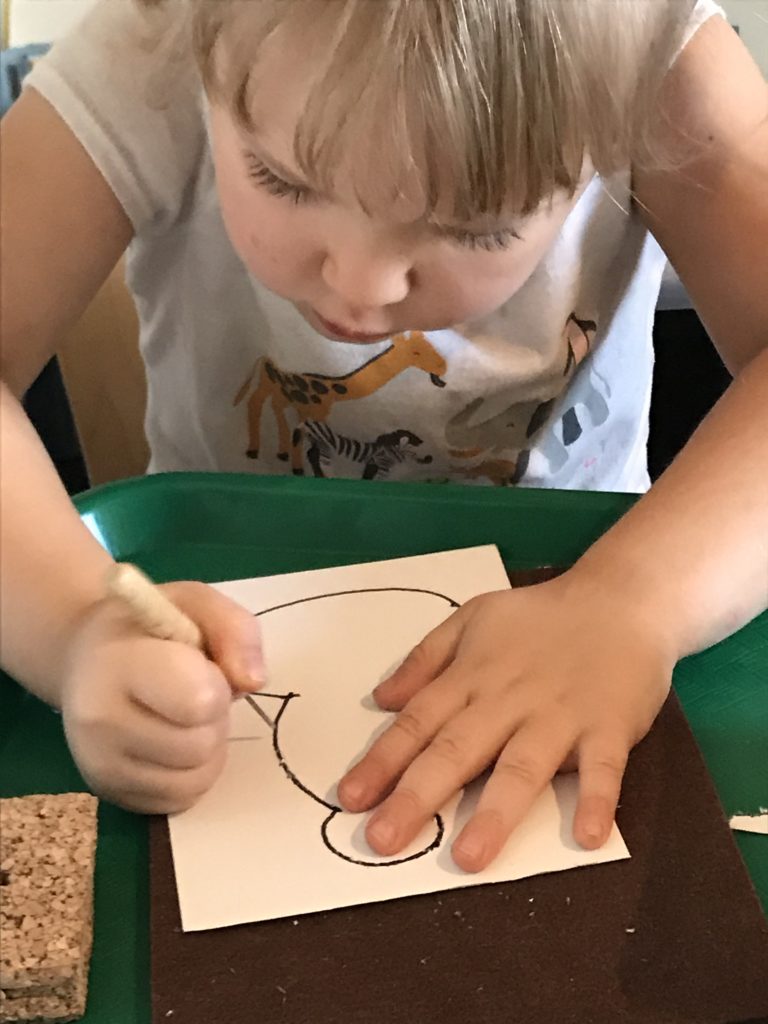
BUT there are some things we can do to push up that schedule, thanks to the observations of Maria Montessori over a century ago. Based on her observations of children in her school, Dr Montessori developed curricula that have stood the tests of time and modern psychology.
She observed that muscular coordination develops before the logical reason that is necessary to read sentences. With this in mind, on our Practical Life shelves the child will finds opportunities learn left-to-right processes–all repetitive muscular motions that will be necessary to write and then read. She can pick up small objects or work with tongs–activities that develop the “pincer grip” with which she will later hold a pencil.
A variety of other Montessori activities also promote the pincer grip: 2-year-olds complete the Math activity of sorting small stones by picking them with the index finger and thumb and carefully placing them on a card; 3- and 4-year olds can perforate shapes in paper, then tear out the shapes to use as decoration. Often this activity can be combined with other curriculum with fantastic results. (See the snowman, above right, or the planets in this previous post.)
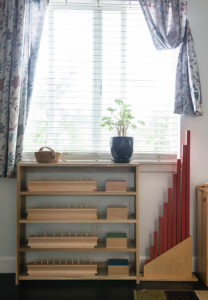 On the Sensorial shelves of our classroom (at left) the young child develops visual discrimination skills when looking at and manipulating the the various shapes and sizes when doing simple matching lessons or working with the incremental sizes such as the knobbed cylinders. This will help when, later, they are asked to differentiate the shapes of, say, an “r,” and “n” and an “h.”
On the Sensorial shelves of our classroom (at left) the young child develops visual discrimination skills when looking at and manipulating the the various shapes and sizes when doing simple matching lessons or working with the incremental sizes such as the knobbed cylinders. This will help when, later, they are asked to differentiate the shapes of, say, an “r,” and “n” and an “h.”
At a young age children can trace or feel the actual shape of letters using our sandpaper letters. While repeating the sound the letter makes, the child internalizes the sound while connecting it to the shape of the letter. Dr Montessori observed that “watching a child makes it obvious that the development of his mind comes through his movements.” She understood the kinesthetic connections that build neural connections long before modern psychology caught up with her insights.
“Written language can be acquired more easily by children of four years than by those of six. While children of six usually need at least two years to learn how to write children of four years learn this second language within a few months.” –Maria Montessori
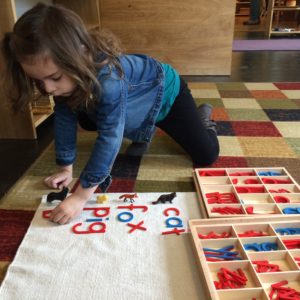
With these connections formed, and still before the child has the fine motor skills to write with a pencil, we use our Moveable Alphabet (wooden letters, at right) to allow the child to spell out simple words like “cat” or “pan.” We’ve seen children work at, and enjoy, doing this for hours on end. Meanwhile, at this age, many children are able to grip a pencil with some ease, but not yet well enough to form letters, the ability to actually write is promoted with the attractive metal inset shelf.
You may have noticed above that Montessori students learn to write before they read. Some of this is due the earlier development of motor coordination, but also because young children are better able to encode than decode. That is, looking at a figurine or picture of a fox, it is easier to sound out (“encode”) the sounds of the word and then figure out its component letters than it is to sort through the many letters on a page (“decode”) and understand the difference of the visual symbols that are the words we know as foxes, boxes, books and socks. Encoding one word at a time and forming it with the moveable alphabet and/or writing it in a journal builds the child’s confidence until the time when they can comfortably sit with a book and read for meaning.
With all of this happening at ages 2, 3 and 4, it’s no surprise that by the time our students are in their third year with us–still before Kindergarten–that they are happily and easily reading simple texts.
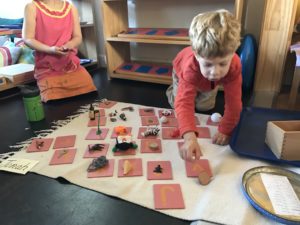
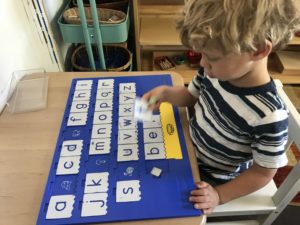
“When the child is given #freedom to move about in a world of objects, she is naturally inclined to perform the tasks necessary for her #development entirely on her own.” — Maria #Montessori pic.twitter.com/dmxh16EZ4N
— Highland Montessori (@HiMontessori) February 2, 2018
